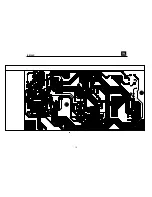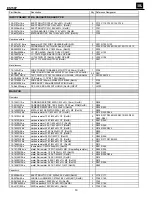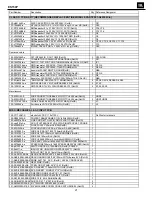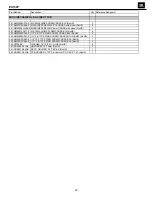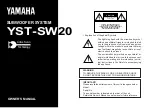
Power On
Plug your subwoofer’s AC cord into a wall outlet. Do not use the outlets on the
back of the receiver.
Initially set the Subwoofer-Level Control
£
to the “min” position.
Turn on your sub by pressing the Power Switch
§
on the rear panel.
Turn on your entire audio system and start a CD or movie soundtrack at
a moderate level.
Auto On/Standby
With the Power Switch
§
in the ON position, the Status LED on the
top will remain lit in red or green to indicate the On/Standby mode
of the subwoofer.
RED = STANDBY (No signal detected, Amp Off)
GREEN = ON (Signal detected, Amp On)
The subwoofer will automatically enter the Standby mode after approximately
10 minutes when no signal is detected from your system. The subwoofer will
then power ON instantly when a signal is detected. During periods of normal
use, the Power Switch
§
can be left on. You may turn off the Power Switch
§
for extended periods of nonoperation, e.g., when you are away on vacation.
Adjust Gain
Turn your Subwoofer-Level Control
£
up to the halfway position. If no sound
emanates from the subwoofer, check the AC-line cord and input cables. Are the
connectors on the cables making proper contact? Is the AC plug connected to
a “live” receptacle? Has the Power Switch
§
been pressed to the “On” position?
Once you have confirmed that the subwoofer is active, proceed by playing a
CD, record or cassette. Use a selection that has ample bass information.
Set the overall volume control of the preamplifier or stereo to a comfortable
level. Adjust the Subwoofer-Level Control
£
until you obtain a pleasing blend
of bass. Bass response should not overpower the room but rather be adjusted
so there is a harmonious blend across the entire musical range. Many users
have a tendency to set the subwoofer volume too loud, adhering to the belief
that a subwoofer is there to produce lots of bass. This is not entirely true.
A subwoofer is there to enhance bass, extending the response of the entire
system so the bass can be felt as well as heard. However, overall balance
must be maintained or the music will not sound natural. An experienced
listener will set the volume of the subwoofer so its impact on bass response
is always there but never obtrusive.
Phase Control
The Phase Switch
¡
determines whether the subwoofer speaker’s pistonlike
action moves in and out with the main speakers, 0˚, or opposite the main
speakers, 180˚. Proper phase adjustment depends on several variables such
as room size, subwoofer placement and listener position. Adjust the phase
switch to maximize bass output at the listening position.
Crossover Adjustment
The Crossover Adjustment Control
¢
determines the highest frequency at
which the subwoofer reproduces sounds. If your main speakers can comfortably
reproduce some low-frequency sounds, set this control to a lower frequency
setting, between 50Hz and 100Hz. This will concentrate the subwoofer’s
efforts on the ultradeep bass sounds required by today’s films and music.
If you are using smaller bookshelf speakers that do not extend to the lower
bass frequencies, set the Crossover Adjustment control to a higher setting,
between 120Hz and 150Hz.
NOTE:
This control will have no effect if the LFE/Normal Selector
™
is set
to LFE. If you have a Dolby Digital or DTS processor/receiver, the Low-Pass
Frequency is set by the processor/receiver. Consult your owner’s manual
to learn how to view or change this setting.
The enclosure may be cleaned using a soft cloth to remove fingerprints or to
wipe off dust.
The grille may be gently vacuumed. Stains may be removed with an aerosol
cleaner, following its instructions. Do not use any solvents on the grille.
All wiring connections should be inspected and cleaned or remade periodically.
The frequency of maintenance depends on the metals involved in the connections,
atmospheric conditions and other factors, but once per year is the minimum.
If a problem occurs, make sure that all connections are properly made and
clean. If a problem exists in one loudspeaker, reverse the connection wires to
the left and right system. If the problem remains in the same speaker, then the
fault is with the loudspeaker. If the problem appears in the opposite speaker,
the cause is in another component or cable. In the event that your subwoofer
ever needs service, contact your local JBL dealer, or visit www.jbl.com for
a service center near you.
OPERATION
6
MAINTENANCE AND SERVICE
ES150/250P (12V) OM 6/21/07 3:03 PM Page 8
ES150P
7
Summary of Contents for ES150P
Page 5: ...ES150P 4...
Page 9: ...ES150P 8...
Page 11: ...ES150P 10...
Page 12: ...ES150P 11...
Page 14: ...ES150P 13...
Page 15: ...ES150P 14...
Page 16: ...ES150P 15...
Page 17: ...ES150P 16...
Page 18: ...ES150P 17...
Page 24: ...ES150P 23...
Page 25: ...ES150P 24...
Page 26: ...ES150P 25...
Page 27: ...ES150P 26...
Page 28: ...ES150P 27...
Page 29: ...ES150P 28...
Page 30: ...ES150P 29...
Page 31: ...ES150P 30...
Page 32: ...ES150P 31...
Page 33: ...ES150P 32...
Page 34: ...ES150P 33...

















